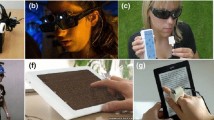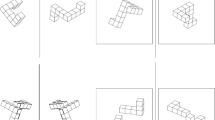Abstract
Background and aims
A mental map of well-known places is organized according to a specific orientation where spatial information located in front of a person is more accessible than information located at the back (front-back effect). This study investigated age-related differences between young and older adults in building a mental map of well-known places when front and back pointing were required.
Methods
Thirty young (20–30 year olds) and 29 older (60–72 year olds) adults living in the same Italian town were compared in their ability to point to places inside their own town, and surrounding villages located in the front and back of their physical position in the city. A series of visuo-spatial tasks were also administered.
Results
Our results showed that young and older adults’ performance in pointing to well-known places did not differ significantly, and that participants were affected by the pointing direction (i.e. forwards vs. backwards) and the type of place (i.e. in town vs. surrounding villages). It was easier for both young and older adults to point to places in town that were in front of them rather than behind them; there were no differences between pointing forwards or backwards in the surrounding villages. The influence of visuo-spatial abilities on pointing performance changed as a function of age: it was only in the older adults (not in the younger) that a spatial visualization task correlated with pointing performance.
Conclusions
This study showed that older adults, despite their spatial cognitive decline shown by visuo-spatial tasks, retained the ability to build a mental representation of well-known places and were specifically sustained by spatial visualization ability.

Similar content being viewed by others
References
Tolman EC (1948) Cognitive maps in rats and men. Psychol Rev 55:189–208
Walsh DA, Krauss IK, Regnier VA (1981) Spatial ability, environmental knowledge, and environmental use: The elderly. In: LS Liben, A Patterson, N Newcombe (eds) Spatial representation and behavior across the life span, New York, NY, Academic Press, pp 321–357
Neisser U (1976) Cognition and Reality. Freeman, San Francisco
Shepard RN (1978) The mental image. Am Psychol 33:125–137
Sholl MJ (1987) Cognitive maps as orienting schemata. J Exp Psychol Learn Mem Cogn 15:110–125
Craik FIM, Salthouse TA (2008) Handbook of aging and cognition, 3rd edn. Psychology Press, New York
Salthouse TA, Babcock RL, Skovronek E, Mitchell DRD, Palmon R (1990) Age and experience effects in spatial visualization. Dev Psychol 26:128–136
Dollinger SMC (1995) Mental rotation performance: age, sex, and visual field differences. Dev Neuropsychol 11:215–222
Herman JF, Coyne AC (1980) Mental manipulations of spatial information in young and elderly adults. Dev Psychol 16:537–538
Inagaki H, Meguro K, Shimada M, Ishizaki J, Okuzumi H, Yamadori A (2002) Discrepancy between mental rotation and perspective-taking abilities in normal aging assessed by Piaget’s three-mountain task. J Clin Exp Neuropsychol 24:18–25
Wilkniss SM, Jones MG, Korol DL, Gold PE, Manning CA (1997) Age-related differences in an ecologically based study of route learning. Psychol Aging 12:372–375
Kirasic KC (2000) Age differences in adults’ spatial abilities, learning environmental layout, and wayfinding behavior. Spat Cogn Comput 2:117–134
Barrash J (1994) Age-related decline in route learning ability. Dev Neuropsychol 10:189–201
Presson CC, Hazelrigg MD (1984) Building spatial representation through primary and secondary learning. J Exp Psychol Learn Mem Cogn 10:716–722
De Beni R, Pazzaglia F, Gardini S (2006) The role of mental rotation and age in spatial perspective taking tasks: when age does not impair perspective-taking performance. Appl Cognitive Psych 20:807–821
Meneghetti C, Fiore F, Borella E, De Beni R (2011) Learning a map of environment: The role of visuo-spatial abilities in young and older adults. Appl Cognitive Psych 25:952–959
Crook TH, Bartus RT, Ferris SH, Whitehouse P, Cohen GD, Gershon S (1986) Age-associated memory impairment: proposed diagnostic criteria and measures of clinical change. Report of a National Institute of Mental Health Work Group. Dev Neuropsychol 1986(2):261–276
Wechsler D (1981) Wechsler adult intelligence scale–revised (WAIS-R). The Psychological Corporation, New York
Park DC, Lautenschlager G, Hedden T, Davidson NS, Smith AD, Smith PK (2002) Models of visuospatial and verbal memory across the adult life span. Psychol Aging 17:299–320
Likert R, Quasha WH (1941) Revised Minnesota Paper Form Board. Psychological Corporation, New York
Vandenberg SG, Kuse AR (1978) Mental rotations, a group test of three-dimensional spatial visualization. Percept Motor Skill 47:599–604
Kozhevnikov M, Hegarty MA (2001) Dissociation between object-manipulation spatial ability and spatial orientation ability. Mem Cognition 29:745–756
Linn MC, Petersen AC (1985) Emergence and characterization of gender differences in spatial abilities: a meta-analysis. Child Dev 56:1479–1498
McKenna FP (1984) Measures of field dependence: cognitive style or cognitive ability? J Pers Soc Psychol 47:593–603
Conflict of interest
None.
Author information
Authors and Affiliations
Corresponding author
Rights and permissions
About this article
Cite this article
Meneghetti, C., Borella, E., Fiore, F. et al. The ability to point to well-known places in young and older adults. Aging Clin Exp Res 25, 203–209 (2013). https://doi.org/10.1007/s40520-013-0027-8
Received:
Accepted:
Published:
Issue Date:
DOI: https://doi.org/10.1007/s40520-013-0027-8




